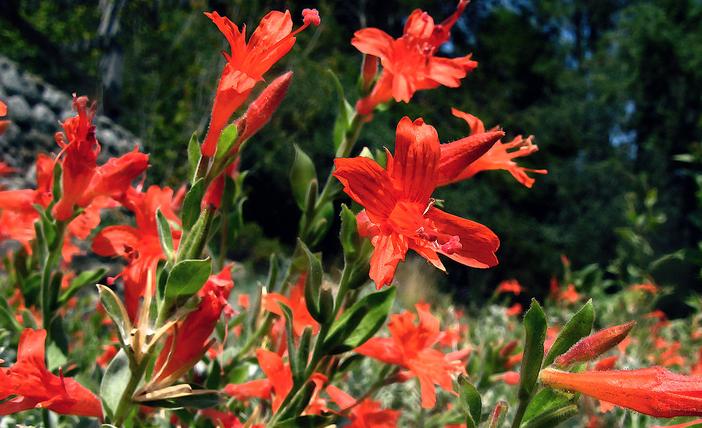Northern Willowherb
(Epilobium septentrionale)
Northern Willowherb (Epilobium septentrionale)
/
/

John Rusk
CC BY 2.0
Image By:
John Rusk
Recorded By:
Copyright:
CC BY 2.0
Copyright Notice:
Photo by: John Rusk | License Type: CC BY 2.0 | License URL: https://creativecommons.org/licenses/by/2.0/ | Uploader: John Rusk | Publisher: Flickr
















Estimated Native Range
Summary
Epilobium septentrionale, commonly known as Northern Willowherb, is a deciduous perennial herb native to chaparral, coastal sage scrub, and open woodlands in California. It thrives in dry, rocky areas, including riverbanks, cliffs, and slopes. This plant typically forms clumps and grows in thin patches of soil between rocks, reaching a modest height. The leaves are oval, pointed, glandular, and covered in a coat of white fuzz, which helps in reducing water loss. The bright red-orange tubular flowers, measuring 2 to 3 centimeters long, are borne on glandular inflorescences at the end of erect branches. The flowers, which are pollinated by nectar-feeding birds, are quite showy with a bunch of stamens and a long pistil protruding from the bloom. The fruit is a hairy capsule about two centimeters long, which aids in seed dispersal.
Northern Willowherb is appreciated for its bright, attractive flowers and its ability to thrive in challenging, dry conditions, making it suitable for rock gardens, xeriscaping, and restoration projects. It is often used to stabilize slopes and prevent erosion. In cultivation, it requires full sun exposure and can tolerate low to medium water conditions, adapting to various soil types with different drainage rates. While it is not commonly affected by diseases, it can be susceptible to root rot in overly wet conditions. Gardeners should be aware of its potential to spread in favorable conditions, which can be managed by deadheading spent flowers to prevent excessive self-seeding.CC BY-SA 4.0
Northern Willowherb is appreciated for its bright, attractive flowers and its ability to thrive in challenging, dry conditions, making it suitable for rock gardens, xeriscaping, and restoration projects. It is often used to stabilize slopes and prevent erosion. In cultivation, it requires full sun exposure and can tolerate low to medium water conditions, adapting to various soil types with different drainage rates. While it is not commonly affected by diseases, it can be susceptible to root rot in overly wet conditions. Gardeners should be aware of its potential to spread in favorable conditions, which can be managed by deadheading spent flowers to prevent excessive self-seeding.CC BY-SA 4.0
Plant Description
- Plant Type: Herb
- Height: 3-4 feet
- Width: 0.75-1 feet
- Growth Rate: Moderate
- Flower Color: Red
- Flowering Season: Summer, Fall
- Leaf Retention: Deciduous
Growth Requirements
- Sun: Full Sun
- Water: Low, Medium
- Drainage: Fast, Medium, Slow
Common Uses
Bee Garden, Bird Garden, Butterfly Garden, Deer Resistant, Drought Tolerant, Fire Resistant, Hummingbird Garden, Low Maintenance, Rock Garden, Showy Flowers
Natural Habitat
Chaparral, coastal sage scrub, and open woodlands in California
Other Names
Common Names: Humboldt County-Fuchsia
Scientific Names: , Epilobium septentrionale, Zauschneria septentrionalis, Epilobium canum subsp. septentrionale, Zauschneria septentrionale,
GBIF Accepted Name: Epilobium septentrionale (D.D.Keck) R.N.Bowman & Hoch